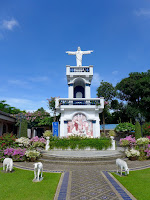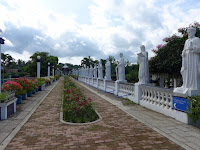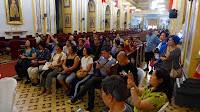LASA at PANANAMPALATAYA sa LIPA
- ITINERARY
Saturday, September 17, 2016
Marian Orchard Shrine (8:30-9:30)
Let’s start our tour in a serene Marian shrine. Have a
welcome snack of Lipa bonete and pan de sal filled with kesong puti, Lipa honey
and burong paho paired with kapeng barako and salabat. Tour the grounds, say a
prayer in their chapel, and imagine your next Visita Iglesia here.
Travel to The Taal Lake Conservation Center (TLCC) &
Taal Lake Conservation Center (10:00-11:30)
Located right on the shore of Taal Lake. After two short
talks and personal stories on Lipa history and culture as well as on Lipa as
“The Little Rome of the Philippines,” by Lipena CHOP members Inez Reyes and
Nanette Medina.
Take a break and have a “pica-pica” (bite size tasting)
snack of Lipa bibingka, suman haba, suman dapa and puto with latik – washed
down with cold sinturis juice.
Enjoy another interesting talk on Taal Lake conservation and
the slow food movement by Lipena Atty Maria Paz “Ipat” Luna Severino, who also
owns “Kapusod,” a bed and breakfast right beside TLCC.
Step Over to Kapusod – Right Next Door To TLCC
(11:30-1:00)
Within a charming “bamboo house,” experience the simple and
straightforward Lipa cuisine with a traditional lunch, using local ingredients
sourced the day itself. Taste a little of each dish from our extensive buffet
spread :
Bulanglang, Pako Salad, Burong Santol, Burong Mangga,
Atcharang Lipa, Ginataang Manok, Kalderetang Kambing, Tinindag (inihaw na baboy
Lipa style), Ginataang Puso, Sinaing na Tulingan, Ginataang Tulingan, and for
dessert, Pilipit and Pastillas Lipa. Have another cup of kapeng barako to wash
it all down.
Scenic Route of Mataas Na Kahoy Towards the Café De Lipa
Coffee Farm (1:00-1:30)
Take the road that cuts through the village of Mataas Na
Kahoy (which was originally part of Lipa) and enjoy the foliage and view of
Taal Lake as we drive by.
Café De Lipa Coffee Farm (1:30-2:30)
See the place where the first coffee tree was planted in
Lipa in the 18th century. Listen to a talk on growing barako coffee
and taste various barako coffee blends.
Travel to Carmel Church (2:30-2:45)
Carmelite Monastery - Shrine of Our Lady Mediatrix of
All Grace (2:45-3:15)
Visit the church, prayer area devoted to Our Lady and the
apparition site. Background talk and personal testimonial by Nanette Medina.
Travel to San Sebastian Cathedral (3:15-3:30)
San Sebastian Cathedral (3:30-4:00)
San Sebastian Cathedral was administered by the Agustinians
since 1605 and was selected as the seat of the Archdiocese of Lipa in 1910.
Guided tour.
Travel to Casa Segunda (4:00-4:15)
Casa Segunda (4:15-5:30)
Pia's announcement email to members, August 22, 2016:
Hi everyone,
Our Lipa tour will take place on Saturday, September 17.
Many many thanks to the dynamic duo of Inez Reyes and Nanette Medina who
made many trips over the last 4 to 5 months just to give us a tour of the best
of what Lipa has to offer not only in terms of food but also for us to visit
the places that have made Lipa a very special place.
Cost of the tour is 1,600 per member and 1,800 per
non-member. The bank details for depositing the fee is in the email sent
by Pia, and not listed here for security reasons.
My apologies, new bank rules must state what is registered
at SEC so the long title. Unless you deposit direct to our branch on
Arnaiz Pasay Road or do online banking, your check must state out the full
name.
Upon deposit, please email me your date and branch of
deposit so I can credit the payment to you.
Deadline for confirmation will be a week before the event on
Friday, September 9. The reason for this is we have to give the funds to
Nanette and Inez who have to in turn give the money to the different purveyors
who will be cooking the food that we will eat.
For transport, I have hired a coaster (same as what we used
for Pampanga) It has 28 seats and we can just divide the cost of the
coaster, the driver’s food and the toll among ourselves. If you are
interested in riding the coaster, please let me know also so I can include you
in the coaster ride.
For the coaster, we will have a 6750 Ayala pickup for
northerners and Makati residents. From there, we can have another pickup
point at either Shell or Petron on SLEX right after Alabang. I will have
to confirm the exact location of this place with those from the area.
For the return, the Alabang people will have to get off at a
station on the opposite side of the road so we don’t have to leave the
expressway just to return to that gas station. The rest will be dropped
off at 6750.
I am also attaching the list of items that you may want to
bring home as pasalubongs and the order form. There are a few on this
list which will need to be pre-ordered so I am also including the order form
which you can fill up and send back to me. I will coordinate with Nanette
and Inez. Some of the pruveyors will also have extra items available for
sale so not to worry if you are not sure of what you want to order.
Payment for this will be in cash directly to the different purveyors.
Many thanks to Inez for making this flyer for all of us.
Super classy!
If anyone has questions, please email me and I do hope many
of you will be able to join our last food tour of the year.
PIA
* * *
Save the Date!!
[Details will be announced shortly.]
Full Story of the Food Tour
Written by CHOP Member Susie Yap
I asked my friend whose parents hailed from
Lipa why she had kept secret from us the places our tour to Lipa had taken us.
Surprised, she exclaimed that she had not
heard of the Marian Orchard, nor had she been to Pusod or Kapusod.
The Marian Orchard boasts of life-sized
statues of the Twelve Apostles that look as if they had been plucked straight
out of St. Peter's Square in Rome and transplanted to the lush hillside
surrounding Taal Lake. The white-washed chapel dedicated to the Sacred Heart
and the open-air pergola housing a statue of Our Lady of Good Voyage was like a
scene along the Mediterranean coastline, save for the tropical nature of the
foliage and the colorful bougainvilleas spilling out of plant boxes and pots in
abundance.
The Orchard was our first stop of the day, and
also our first meal. Tasty Pan de Sal and Bonete Bread were served with newly
made Kesong Puti drizzled with Honey gathered from surrounding farms. This was
washed down with cups of steaming Café Barako. The combination of Keso and
Honey was new to me, a native of Laguna, but it was good!
From the Orchard, we proceeded to
"Pusod," or the Taal Lake Conservation Center located along the shore
of Taal Lake itself. Food still seemed to be paramount in our minds and a
heavier snack of different rice cakes awaited the CHOP members: Bibingka,
Puto, Suman, and Hot Chocolate made from Tablea. There was also fresh Buko Juice
.
It was only after we took our last bite that
our lively Lipeña hosts, Inez Reyes and Nanette Medina, explained
how they had coined our tour "Lasa and Panampalataya" (“Taste
and Faith”). Their informative lecture illustrated how closely interwoven food
and religion were in the Batangueños' culture.
Conservationist lawyer Ipat Luna Severino
gave us a comprehensive briefing on how Taal Volcano dominated the lives of the
Lipeños and neighboring lakeshore towns. Taal's frequent rumblings and
eruptions shaped the cuisine, culture, and religiosity of these people. Ipat,
together with our special guest, Chef Myrna Segismundo, told us that
Lipa's food evolved around these volcanic eruptions. The people learned to cook
dishes that were quick and easy to bring along and would not spoil easily when
they evacuated to safer grounds. Talk about "disaster preparedness!"
They furthered told us that Lipa's fiesta fare
was that of rich classes and heavily influenced by the Spanish palate of the
Agustinian Friars who first introduced coffee planting into the country. Lipa's
cool climate and rich volcanic soil gave rise to a lucrative coffee trade that
brought wealth to many Lipeños. However, the Lipeños’ daily food was the simple
comfort food cooked by the farmhands or "kasamas." This food
was always fresh and consisted of what was in season.
To give us a better insight into what this
cuisine was really like, Chingbee Kalaw gifted all attendees with copies
of the first cookbook ever published in the country. The author was her
grandmother, Pura Kalaw Villanueva, a native of Lipa. This was first
published in 1918 and was in Spanish. What a precious legacy!
From the Conservation Center, it was a short
walk over to "Kapusod," Ipat’s beautiful bamboo home. It was on the
open ground floor of this home where Chef Myrna demonstrated how to cook
her family's heirloom Adobo recipe. Myrna, whose parents hailed from Lipa,
admitted she was thrilled to be invited to cook in Lipa. This was the first
time she had been invited! Goes to show prophets are not appreciated in their
own land. Indeed, the Adobo was delicious. I went back again and again and
poured the sauce over steaming rice.
This I did over and above partaking of the
generous buffet of Lipa cuisine that was laid out after the cooking class.
Inihaw na Baboy (cooked over burnt coconut husks and not ordinary charcoal),
Kaldereta, Sinaing na Tulingan, Crispy Fried Bia, Pakô (Fern) Salad, Ginataang
Puso ng Saging, various Acharas of Papaya, Santol and Mango, and much more
filled our plates. We all spread out to sit at tables in the garden and the
ground floor. A steady breeze from Taal Lake whetted our appetites even more,
and after we had our fill, this same breeze lulled us into a stupor. This was
provincial life at its best . . . fresh air, good food, and a peacefulness not
present in the city.
The second half of the day was spent in Lipa
City itself, starting off with an interesting visit to Café de Lipa, the
headquarters of an important maker of Café Barako.
Marilen Mercado (a 3rd generation family member) ably lectured us on the
history of Lipa's coffee, passed around samples of the different varieties of
coffee beans, and allowed us to taste the different varieties. It was only after
this that we were let loose in their Café cum store to purchase our coffee
needs to share back home.
With much of the "Lasa" activities
behind us, we moved into the "Panampalataya" phase of the tour.
Our personal guide to the Carmelite Monastery
was tourism officer Aylene Acorda, who was born in Zamboanga but has
made Lipa her home. Aylene arranged access to the apparition site within the
Monastery, related to us how the Virgin had appeared to Sister Teresing
Castillo and, on several occasions, made her presence felt by showering the
chapel with roses. We were able to catch the tail end of a private mass while
we were there, and Marie Guanio recognized the celebrant, Fr. Gerard
Deveza. She talked to him after the final blessing was given and asked that
she and I be prayed over by the healing priest.
Our next stop was the Grand Cathedral of San
Sebastián, the seat of the Diocese of Lipa. A volunteer devotee took over as
guide, narrating how her devotion to the patron saint had personally helped
her. She drew our attention to the altar tableau covered in beaten silver, the
beautiful frescoes painted on the ceiling by a native Batangueño, and the huge
and still functioning pipe organ to the right of the altar. It was an
extra bonus for the CHOP group to pass through the Holy Door of the Cathedral
and gain indulgences.
Blessed by visits to these two important
religious landmarks, we proceeded to another landmark, this time of romantic
interest: Casa Segunda. Here we were met by Aylene Acorda again,
this time with a bevy of young girls and boys all dressed in colorful native
costumes. It was already twilight as we were ushered into a gracious courtyard
surrounded by shade trees and vines. An old fountain sat in the middle. A huge
well-preserved "Bahay na Bato" was warmly lighted and welcoming.
Segunda Katigbak, after whom the place was named, was national hero Jose Rizal's
first sweetheart. Lilet Malabanan, a direct descendant of Segunda,
shared the history of this beautiful home with us. She invited us to explore
the house and go upstairs after the young girls and boys gave us a little
cultural presentation by dancing the "Subli,"a dance taught to the
young Lipeños when they are in school.
Casa Segunda provided the venue for the tour's
final meal and cooking demonstration. We witnessed how two energetic young
cooks worked their magic with huge woks to turn out warm heaping portions of
steaming noodles in a tasty broth and topped with generous portions of Lechon
Kawali, Quekiam, and Fried Bola-Bola toppings. As if that wasn't a meal in
itself, we were served Puto, Pinindot and Tsokolate with Pinipig, just to
counter the rich savory broth.
Now if one wanted to bring home and share the
goodness of the day's food tastings, Nanette and Inez had thoughtfully invited
several of Lipa's artisanal purveyors so the members could purchase their
goodies. Top sellers were the Lipa Pan de Sal (the bakery had to do a special
batch for last-minute orders), the Bibingka (produced by D Lover's Line), the
Kesong Puti and Sinaing na Tulingan.
We departed from Lipa happy after a full day
of eating, praying and sharing stories.
When we hear the name Lipa mentioned, it will
never be the same, thanks to the team that put this tour together and enriched
our knowledge and appreciation of this historical city.
* * *
Group Shots
* * *
The Marian Orchard Shrine and the San Sebastian Cathedral




* * *
The Taal Lake Conservation Center
The Big Lunch & Cooking Demo at Ipat Severino's "Kapusod" Bed & Breakfast
* * *
At the Cafe de Lipa
* * *
At the Casa de Segunda - Entertainment and the Last Big Meal
* * *
The Food
* * *
Group Shots
* * *
The Marian Orchard Shrine and the San Sebastian Cathedral




* * *
The Taal Lake Conservation Center
The Big Lunch & Cooking Demo at Ipat Severino's "Kapusod" Bed & Breakfast
* * *
At the Cafe de Lipa
* * *
At the Casa de Segunda - Entertainment and the Last Big Meal
* * *
The Food



















































































































































































It was an honor to be part of your LIPA BALETE TOUR ...HOPE YOU DID HAD A GREAT TIME WITH US...THE FOOD...THE BEAUTIFUL PLACES
ReplyDelete